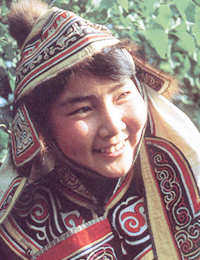 With a population of 121,357 (as of 1990), the Daur people mainly live in Inner Mongolia, Heilongjiang and Xinjiang together with the Han or other ethnic groups.
With a population of 121,357 (as of 1990), the Daur people mainly live in Inner Mongolia, Heilongjiang and Xinjiang together with the Han or other ethnic groups.
The Daur language belongs to the Mongolian Austronesian of Altai Phylum. They have no written language of their own. During the Qing Dynasty (1644-1911), they used Manchu as their written language. The Daur people communicate with each other, and with the other local ethnic groups, in Chinese, Mongolian, Uygur, Kazak, and Ewenki. Since the 1911 Revolution, mandarin Chinese has replaced the Manchu language.
The Daur people are thought to be descendants of the Khitan, an ancient nomad tribe who lived in the lower reaches of the Heilongjiang River and founded the Liao Dynasty (916-1125). In the early Qing Dynasty (1644-1911), groups of Khitans migrated into China's western region and formed a new ethnic minority-- the Daur people. During the Qing Dynasty, the Daurs moved south and settled on the banks of the Nenjiang River, from where they were constantly conscripted to serve in the armies of the Qing emperors and in garrisons all over the Chinese empire. The Daurs even helped to repel Cossack invaders from Tsarist Russia in 1643 and 1651.
The Daur people are mainly engaged in agriculture, along with stockbreeding and hunting. They believe in shamanism, while a few are followers of Lamaism.
The biggest festival of the year is the Anie Festival, the local Spring Festival. In May of the Gregorian calendar, pigs and oxen are sacrificed to the gods to ensure prosperity for the coming year. The Daurs also have the Mid-autumn Festival just like the Hans.
The Daurs are good dancers and singers. In addition, wrestling, horse racing, archery, and field hockey are their favorite sports. The Daur region is even called "the Birthplace of Field Hockey".
